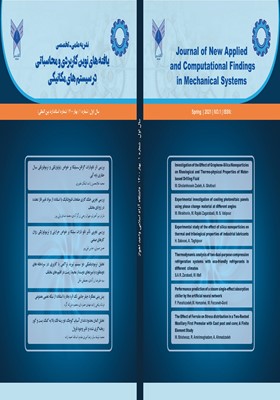بررسی اثر نانوذرات گرافن-سیلیکا بر خواص رئولوژیکی و ترموفیزیکی سیال حفاری پایه آبی
محورهای موضوعی : یافته های نوین کاربردی و محاسباتی در سیستم های مکانیکی
محمد غلامحسین زاده
1
,
اشکان غفوری
2
*
![]()
1 - دانش آموخته کارشناسی ارشد، گروه مهندسی مکانیک، واحد اهواز، دانشگاه آزاد اسلامی، اهواز، ایران
2 - گروه مهندسی مکانیک، واحد اهواز، دانشگاه آزاد اسلامی، اهواز، ایران
کلید واژه: نانو ذرات, ضریب هدایت حرارتی, خواص رئولوژی, گل حفاری پایه آبی,
چکیده مقاله :
گل حفاری یکی از مهمترین و اساسی ترین ملزومات عملیات حفاری چاه های نفتی و گازی است. بهینه سازی خواص سیال حفاری منجر به کاهش زمان و هزینه های حفاری میشود. گل حفاری پایه آبی یکی از انواع سیال حفاری است که بدلیل سازگاری با محیط زیست بصورت عمده در عملیات حفاری چاه ها کاربرد دارد. در این پژوهش به منظور بالا بردن بازدهی این نوع سیال حفاری از نانو ذرات گرافن و سیلیکون اکسید به نسبت وزنی برابر در گل حفاری پایه آبی استفاده شده است. این پژوهش به بررسی اثر غلظت های مختلف (۲۵/۰، ۵/۰، ۷۵/۰ و ۱ درصد کسر حجمی) این نانوذرات بر خواص مختلف سیال حفاری از قبیل گرانروی پلاستیکی، نقطه واروی، استحکام ژله ای ۱۰ دقیقه و ۱۰ ثانیه، حجم صافاب گل و ضریب هدایت حرارتی پرداخته است. تمامی آزمایشات خواص رئولوژیکی بر پایه استاندارد (API RP 13B) انجام شده است. از روش سیم داغ گذرا برای تعیین ضریب هدایت حرارتی سیال استفاده شده است. نتایج نشان می دهد افزایش نانوذرات تاثیر بسزایی بر خواص رئولوژیکی و ترموفیزیکی گل حفاری پایه آبی داشته و سبب کاهش ویسکوزیته پلاستیک (15 درصد)، کاهش حجم صافاب (25 درصد) و استحکام ژله ای و همچنین افزایش ضریب هدایت حرارتی به میزان 16 درصد در کسر حجمی 1 درصد می گردد.
Drilling mud is one of the most important and basic requirements for drilling oil and gas wells. Optimization of drilling fluid properties leads to reduce drilling time and costs. Water-based drilling mud is one type of drilling fluid that is mainly used in drilling wells due to its environmental compatibility. In this research, in order to increase the efficiency of this type of drilling fluid, graphene and silicon oxide nanoparticles in equal weight ratio in water-based drilling mud have been used. This study investigates the effect of different concentrations (0.25, 0.5, 0.75 and 1% volume fraction) of these nanoparticles on different properties of drilling fluid such as plastic viscosity, yield point, gel strength of 10 minutes and 10 seconds, circulation loss of the samples and the coefficient of thermal conductivity are discussed. All rheological properties tests are performed according to the standard (API RP 13B). The transient hot wire method has been used to determine the thermal conductivity of the fluid. The results show that the increase of nanoparticles has a significant effect on the rheological and thermo-physical properties of water-based drilling mud and reduces plastic viscosity (15%), decreases circulation loss of the samples (25%) and gel strength and also increases the thermal conductivity by 16% in the volume fraction of 1%.
_||_

